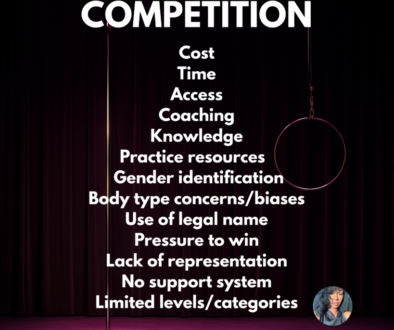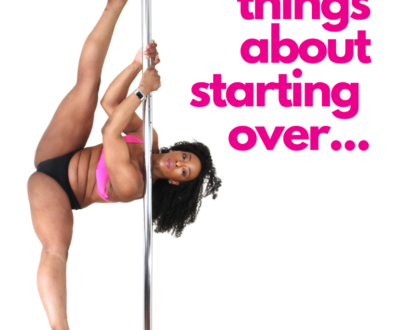Instructor Certification: Part 1
Initially, this post was a part of my Spin City Beginner Lyra Training review. I wanted to share my thoughts on that experience, but as I started writing I realized that I had much more to share on teaching training and certification in general. I decided that separating my training thoughts from that training experience was the best route, and much easier for those of you reading this to digest! So after you check out part one, feel free to jump right into part two which is linked at the bottom.
I consider myself a lifetime learner and I’m forever nerding out, specifically in my aerial journey. The thirst for information and diverse training has become sort of an addiction. Books, articles, workshops, privates, training sessions, online certifications, you name it…I’m all for it! I feel like there is always new information, techniques, and resources popping up that I can use to improve my craft – as an athlete and as an instructor. As an instructor, I feel like I have the responsibility to myself to continue working on my personal development, and to my students to continue learning so that I may improve my work with them on their goals.
My aerial journey started in 2009, and I attended my very first teacher training/certification in 2012. Although it until 2014 (ish) that I actually started teaching. When I attended the training, it was not with the intention of teaching. Instead, I simply wanted to solidify the foundations to better my personal growth. Let me tell you, it was everything I hoped it would be and more. Certification is one of the best moves you can make as an aerial athlete and as someone that has an interest in teaching.
I think sometimes when people attend a certification, it’s with the assumption that they are ready to teach and should be in the classroom the next day. However, I don’t see it that way. Just because someone completes a certification does not necessarily mean that they should or are ready to teach. To me, it just means that they had some discretionary income available to put towards it, along with an interest in teaching (hopefully).
In my opinion, when you do a certification, you don’t leave with every single tool and ability you need to be the perfect instructor. However, you do leave feeling empowered and armed with knowledge and resources that you can use to help develop your teaching ability and your personal teaching style. I also believe teacher trainings aren’t just for new or hopeful teachers. Continuing education should be a normal part of any aerial instructor’s growth and development as a classroom leader – as it is with most other professions. I also believe that cross training is another key element that both instructors and students should incorporate into their regimen.
My Top Five Tips For Those Thinking About Teacher Training:
1. Do Your Research. Every program has its pros and cons. Do a self-assessment, what do you already know? What do you feel you’re lacking? Where are you teaching (or wanting to teach) and what are their qualifications/requirements? What are your areas of weakness? Compare your findings against the offerings of each program to see what’s the best option for you.
2. Consider the Investment. Look at the cost of the program and the overall value it will add to your ability and teaching resume. You aren’t just investing your money, but also your time, so ensure that the training will provide a solid ROI. How long will it take you to make your money back via studio classes and/or private lessons?
3. Look at training options. Some certification programs offer online training options, which in my experience are slightly cheaper. Consider your learning preferences. If you are good with self-management and time management then online training may work better for you, while saving you some green. If you’re hands on, prefer immediate feedback or just like in-person training then on-site will be the best option for you.
4. Plan for a Nesting Period and Practice. Allow yourself sufficient time to absorb and apply the materials learned in training. Give yourself a nesting period where you can get settled into the dutiles and skills needed for your new role. Before jumping into a teaching position, practice your teaching skills and develop your personal teaching style. If you have the ability, shadow other instructors that teach the same class/level that you’re wanting to teach and if they allow, offer to lead certain parts of the class for them such as the warm up, cool down or conditioning drills.
5. Continuing Education. Training isn’t over once you receive that certificate. Make your training the beginning of an endless journey. Students will always be working to advance in their craft and so should you. Engage in discussion with other instructors, get feedback from students and studio owners, consume any and all resources you can get your hands on, cross-train, and do any additional programs/certifications that you can (and that provide good ROI)
BONUS TIP: Black Friday, Cyber Monday and Christmas have the best sales!
Read part two: Instructor Certification Part Two Spin City Lyra




